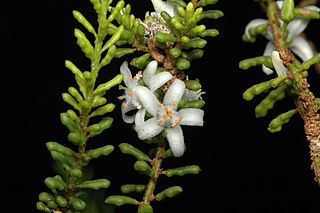
Philotheca spicata, commonly known as pepper and salt, is a species of flowering plant in the family Rutaceae and is endemic to the south-west of Western Australia. It is a small shrub with linear to narrow elliptical leaves and pink, mauve or blue flowers arranged in a raceme on the ends of branchlets.

Philotheca salsolifolia is a species of flowering plant in the family Rutaceae and is endemic to New South Wales and the Australian Capital Territory. It is a shrub with crowded, more or less cylindrical leaves and pink to mauve flowers with a dark central stripe and arranged singly or in twos or threes on the ends of branchlets.

Philotheca buxifolia is a species of flowering plant in the family Rutaceae and is endemic to New South Wales. It is a shrub with more or less oblong leaves and solitary white to pink flowers arranged singly on the ends of branchlets.

Philotheca brucei is a species of flowering plant in the family Rutaceae and is endemic to Western Australia. It is a shrub with cylindrical leaves grooved along the top and in spring, white to pink or mauve flowers with five egg-shaped petals.
Philotheca apiculata is a species of flowering plant in the family Rutaceae and is endemic to the south-west of Western Australia. It is a small shrub with narrow club-shaped leaves and small clusters of white to pink flowers on the ends of branchlets.
Philotheca brevifolia is a species of flowering plant in the family Rutaceae and is endemic to a small area in south-western New South Wales. It is a spreading shrub with fleshy, sessile, cylindrical leaves and white to pink flowers arranged singly or in small groups on the ends of branchlets.

Philotheca coccinea is a species of flowering plant in the family Rutaceae and is endemic to Western Australia. It is a shrub with club-shaped leaves that are warty on the lower surface, and red to pink flowers arranged singly in leaf axils.

Philotheca conduplicata is a species of flowering plant in the family Rutaceae and is endemic to eastern Australia. It is a shrub with elliptical leaves clustered near the ends of the branchlets and white flowers arranged singly or in two or threes on the ends of the branchlets.

Philotheca epilosa is a species of flowering plant in the family Rutaceae and is endemic to eastern Australia. It is a shrub with egg-shaped to lance-shaped leaves with the narrower end toward the base and crowded near the ends of the glandular-warty branchlets, and white flowers usually arranged singly on the ends of the branchlets.
Philotheca ericifolia is a species of flowering plant in the family Rutaceae and is endemic to New South Wales. It is a much-branched shrub with glandular-warty branchlets, needle-shaped leaves and white to pink flowers arranged singly or in groups of up to six on the ends of the branchlets.
Philotheca falcata, commonly known as the sickle-leaved waxflower, is a species of flowering plant in the family Rutaceae and is endemic to a small area in the south-west of Western Australia. It is a small, densely branched shrub with narrow club-shaped leaves and single flowers on the ends of branchlets.

Philotheca gardneri is a species of flowering plant in the family Rutaceae and is endemic to the south-west of Western Australia. It is a shrub with crowded, narrow club-shaped or more or less spherical leaves and white flowers with a prominent pink midrib, usually borne singly on the ends of branchlets.
Philotheca glabra is a species of flowering plant in the family Rutaceae and is endemic to the inland south-west of Western Australia. It is a small shrub with elliptical to club-shaped leaves and white flowers tinged with pink and arranged singly or in twos or three on the ends of branchlets.
Philotheca kalbarriensis is a species of flowering plant in the family Rutaceae and is endemic to Western Australia. It is a shrub with reddish brown branchlets and crowded, narrow spindle-shaped leaves and single white flowers arranged in leaf axils.

Philotheca pachyphylla is a species of flowering plant in the family Rutaceae and is endemic to Western Australia. It is a small shrub with fleshy, oblong, prominently glandular-warty leaves and white flowers arranged singly in leaf axils.
Philotheca rhomboidea is a species of flowering plant in the family Rutaceae and is endemic to the south-west of Western Australia. It is a small undershrub with thick, broadly elliptic to round leaves and white to pale pink flowers arranged singly or in twos or threes at the end of branchlets.

Philotheca sericea is a species of flowering plant in the family Rutaceae and is endemic to the south-west of Western Australia. It is an undershrub with small oval to elliptical leaves and white to pink flowers usually arranged singly at the end of branchlets.

Philotheca thryptomenoides is a species of flowering plant in the family Rutaceae and is endemic to the south-west of Western Australia. It is a small undershrub with oval to club-shaped leaves and white flowers with a broad, reddish-brown stripe, arranged singly on the ends of branchlets.

Philotheca virgata, commonly known as Tasmanian wax-flower, is a species of flowering plant in the family Rutaceae and is endemic to south-eastern Australia. It is a slender, erect shrub with wedge-shaped to oblong leaves and white or pale pink flowers at the ends of branchlets. It is the only philotheca with four sepals and petals.
Philotheca wonganensis, commonly known as Wongan philotheca, is a species of flowering plant in the family Rutaceae and is endemic to the south-west of Western Australia. It is a shrub with thin, cylindrical leaves and white flowers with a pink central stripe, usually arranged singly in leaf axils.













